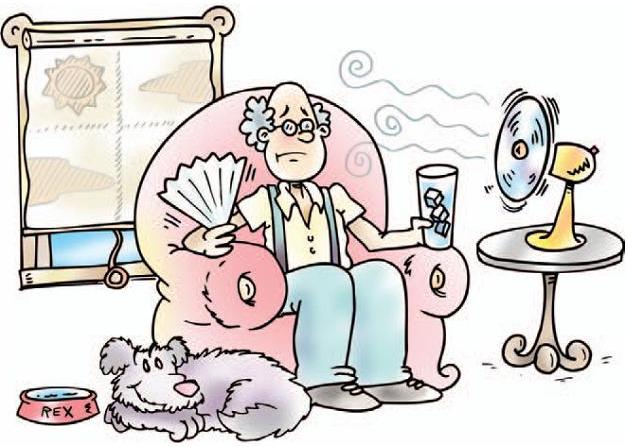A heat wave is an extended period of extreme heat, and is often accompanied by high humidity. These conditions can be dangerous and even life- threatening for people who don't take the proper precautions.
.jpg) Prepare for a heat wave by checking to see that your home's cooling system works properly.
Prepare for a heat wave by checking to see that your home's cooling system works properly.
- Make sure your home is well insulated, including weather stripping around doors and windows.
- Keep storm windows up all year.
- Plan on being inside a cool building during the hottest time of the day.
- Cover windows that receive morning or afternoon sun with drapes, shades, or awnings.
- Never leave children or pets alone in a closed vehicle.
- During a heat wave, slow down and avoid strenuous activity. Stay inside as much as possible. If air conditioning is not available, consider going to a public building or to the lowest floor and staying out of the sunshine. Wear lightweight, light-colored clothing. Drink plenty of water regularly and often even if you do not feel thirsty. Avoid drinks with alcohol or caffeine. Eat small meals and eat more often.
- If someone is experiencing heat cramps, get them to a cooler place and have him or her rest in a comfortable position. Lightly stretch the affected muscle and replenish fluids at a rate of a half glass of cool water every 15 minutes. Do not give caffeinated or alcoholic liquids, which can worsen conditions.
- Watch for signs of heat exhaustion, including cool, moist, pale, or flushed skin; heavy sweating; headache; nausea or vomiting; dizziness; and exhaustion. Body temperature will be near normal. If you see signs of heat exhaustion, get the person out of the heat and to a cooler place. Remove or loosen tight clothing and apply cool, wet cloths, such as towels or sheets. If the person is conscious, give him or her cool water to drink.
-
 Watch for signs of heat stroke, including hot, red skin; changes in consciousness; rapid, weak pulse; and rapid, shallow breathing. Body temperature can be very high—as high as 40ºC / 105º F. If the person was sweating from heavy work or exercise, his or her skin may be wet otherwise, it will be dry. If you see signs of heat stroke, call 9-1-1 and get help fast. Move the person to a cooler place. Quickly cool the body by immersing the victim in a cool bath or wrapping wet sheets around the body and fanning the victim. Keep the person lying down and continue to cool the body any way you can. If the person refuses water or is vomiting or his or her level of consciousness changes, do not give them anything else to eat or drink.
Watch for signs of heat stroke, including hot, red skin; changes in consciousness; rapid, weak pulse; and rapid, shallow breathing. Body temperature can be very high—as high as 40ºC / 105º F. If the person was sweating from heavy work or exercise, his or her skin may be wet otherwise, it will be dry. If you see signs of heat stroke, call 9-1-1 and get help fast. Move the person to a cooler place. Quickly cool the body by immersing the victim in a cool bath or wrapping wet sheets around the body and fanning the victim. Keep the person lying down and continue to cool the body any way you can. If the person refuses water or is vomiting or his or her level of consciousness changes, do not give them anything else to eat or drink.
Developed by NFPA. Funding provided by the U.S. Department of Homeland Security, Office of Domestic Preparedness.